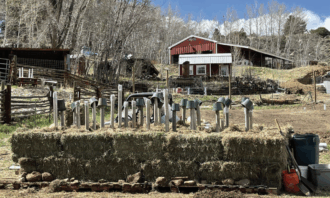A former Chicago science teacher turned Colorado farmer, Rick Bieterman isn’t afraid of a challenge. Start with the location of his Watershed Ranch near Buena Vista in central Colorado.
“Soil quality out here is pretty terrible,” he said. “Organics are way low. We’re right next to the Arkansas River, so most of our fields are heavy in sand. Then it’s just so dang dry. Our annual precipitation is only 11 inches. We’re high alpine desert and in the areas that aren’t irrigated, I’ve got cactus growing. I mean, 100 years ago nobody probably should have started farming in this desert. Folks made bad choices a long time ago, and now we’re all just dealing with it.”
Add over 8,000 feet of elevation – giving farmers about 90 to 100 days of frost-free growing season – and a two-hour drive to just about anywhere, and yeah, it’s a challenge. But science is all about overcoming challenges.
Bieterman, who like most of his neighbors grows hay, got connected with Colorado’s Saving Tomorrow’s Agricultural Resources (STAR) program, which focuses on soil health practices, and began trying to improve his land.
“My goal when COVID hit was to try to figure out how to get off synthetic fertilizers,” he said. “Prices soared. Synthetic fertilizers were something I just wanted to get away from and be more self-sustainable. With the STAR program, my goal was to figure out how to do that.”
He found a grower four hours south who was producing high-fungal-content compost and bought some to test.
“The idea is that you figure out how to use that compost on large acreage,” he explained. “I’ve used it on our large pivot, a 35-acre plot of land. What I did was purchase his compost, and then I turned it into a liquid and then injected it through the pivots onto the hayfields.”
He tried different concentrations and a control plot of standard synthetic fertilizer, testing both soil samples and yield data.
“But I was driving eight hours round trip and paying $3 a pound for this guy’s compost,” he said. “That’s what led to the SARE grant, thinking, ‘Why don’t we just try to make our own?’ Let’s try to make our own and do it in a cost-effective manner, with only supplies that you have on the farm. I wanted to cut costs and also try to use things that are better for the planet.”
So last year, Bieterman built two compost piles.
“They’re both about 20 yards long by about eight feet high and about 10 feet wide,” he said. “One of them is what I would consider a traditional windrow shape. It’s got about two to three feet of Aspen wood chips on the bottom, followed by a manure straw slurry, and then topped off with hay.”
The other pile is a modified bioreactor that looks similar to a traditional compost pile but with breather vents built into it. “The idea of the vents is that it stays aerobic,” he explained “The goal is to keep a high moisture in order to produce a fungal- versus bacterial-dominant compost. Then you infuse it with worms, I do red wigglers, and the worms continue in there for a year straight and do well. At the end of the year, you break it down and there’s about 10,000 worms that are thriving in there, and they did their thing over time.”
First-year results were mixed, with the traditional compost pile doing well but some freezing in the bioreactor pile due to the added moisture.
“Even though it has a border of hay, as an insulation barrier and then a topcoat of hay, it froze over on one side,” he said. “The worms migrated over to the other side because they were still living when I broke it down, but they didn’t spread throughout the entire pile and it didn’t produce as good of a fungal-dominant compost as the traditional windrow.”
There was one unqualified success in year one.
“I did a cost effectiveness comparison vs. driving down to the San Luis Valley and paying three bucks a pound for the compost,” he said. “I was able to create my own for about 30 cents a pound. So that’s exciting to me. I know every rancher up and down this valley complains about costs of fertilizer, and I have a lot of neighbor farmers who are intrigued by what I’m doing.”
So, in year two, Bieterman plans to repeat the experiment and gather more data before making tweaks to optimize the system. Then he wants to test the application of compost liquid vs. spreading solids. And perhaps change his forage mixture to find synergistic benefits between the plants and fungal-forward compost.
The challenge will be getting yields high enough to compete with synthetic fertilizer, at least on a net-profit basis. And while compost may not come out ahead, he hopes to make it close.
“If you can farm more in line with your own values and the way you want to farm and do it successfully – even if it’s not optimally – that’s a win.”
Hear more about this project on Western SARE's Fresh Growth podcast episode "Watershed Ranch: Fungal Compost to Improve Soil Health in High Desert Colorado."
This story was featured in the spring 2025 edition of Western SARE's bi-annual magazine Simply Sustainable. Download the entire edition here.
